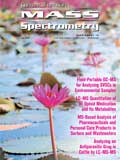Visualize Your Process Streams in Real-Time with MS for Rapid Process Development
Special Issues
The Diablo 5000A RTGA-MS allows the process stream to be seen in real-time and provides quantitative data with reliable mass information. The result is visualization.
The Diablo 5000A Real-Time Gas Analyzer (RTGA) is a real-time chemical measurement tool for continuous process improvement. It is ideal for applications where fast chemical analysis is required, such as monitoring process transients and dynamic continuous reactions. The 5000A RTGA can be used for fuel cell gas analysis, syngas monitoring, catalyst research, monitoring of volatile solvent residues, pharmaceutical reactor headspace monitoring, and many other applications.
Reliable chemical and engineering information is critical for rapid process development. Often, common sensors are either simple or slow, and they provide limited information. The result is nearly blind operation and slow development progress. The Diablo 5000A RTGA-MS allows the process stream to be seen in real-time and provides quantitative data with reliable mass information. The result is visualization.
Process development experiments can often be performed more rapidly with reduced quantities of reagents and materials such as catalysts with a higher efficiency process test device. This reduces the requirements for rare or costly catalysts during screening, reduces consumption of chemicals and related potential hazards. However, as experimental time is reduced, the ability to follow the process in real-time becomes even more critical. For modern experiments, the measurement systems need to be designed as an integral part of the experiment. The experiment shown in Figure 1 begins with a monitoring of the starting materials. Then at about 9 min, the catalyst is placed in-line and the composition of the process stream changes in seconds. But the process returns to the original reagent conditions after only 5 min of catalyst exposure. The RTGA allows this to be followed with high data acquisition rates in real-time. Thus, the process can be visualized on a time basis with the detail of mass information as it changes on the seconds time scale.

Figure 1: Real-time monitoring of starting materials, addition of catalyst at 9 min showing reaction products; catalyst lasts only about 5 min.
The RTGA is designed to allow real-time measurements on a quantitative basis. Simpler and lower-cost designs would only result in rough trend monitoring. The RTGA interface (Figure 2) has been designed to control or account for fluctuations in sample pressure, present the correct concentration range to the very sensitive mass spectrometer (MS), and connect real world pressures to the vacuum world of MS. Poor instrument designs with excessive system drift will confuse process results. The RTGA is also very flexible and easy to adapt to different experiments that might present a wide requirement for mass range, scan speeds, matrix omission, real-time calibration, and calculations.

Figure 2: RTGA interface design to MS. Shows process stream sampling to detection by Agilent MSD.
Fast, flexible, rugged real-time response to process changes are benefits of the Diablo 5000A RTGA direct-to-MS design. However because this system uses the 5977B Agilent MSD, quick and easy conversion for GC–MS applications can be achieved by adding an Agilent 7890B GC for additional system flexibility.
Conclusion
The RTGA-MS, based on the proven Agilent MSD platform, is designed to be robust and stable for engineering research and development environments. The system can be configured to measure masses from hydrogen to heavier vaporizable organic molecules. This system allows rapid process development due to the use of reliable information and visualization in real-time. Gone are the clumsy estimation-based trend monitoring tools of the past. The capability to acquire quantitative mass information by MS is powerful and provides quick, reliable knowledge about the process stream.

Diablo Analytical, Inc.
5141 Lone Tree Way, Antioch CA 94531
tel. (925) 755-1005 x115
Website: www.diabloanalytical.com

Understanding FDA Recommendations for N-Nitrosamine Impurity Levels
April 17th 2025We spoke with Josh Hoerner, general manager of Purisys, which specializes in a small volume custom synthesis and specialized controlled substance manufacturing, to gain his perspective on FDA’s recommendations for acceptable intake limits for N-nitrosamine impurities.
University of Rouen-Normandy Scientists Explore Eco-Friendly Sampling Approach for GC-HRMS
April 17th 2025Root exudates—substances secreted by living plant roots—are challenging to sample, as they are typically extracted using artificial devices and can vary widely in both quantity and composition across plant species.
Determining the Serum Proteomic Profile in Migraine Patients with LC–MS
April 17th 2025Researchers used liquid chromatography–mass spectrometry (LC–MS) in their proteomic analysis to compare the serum proteome of migraine patients with healthy controls and to identify differentially expressed proteins as potential migraine biomarkers.











